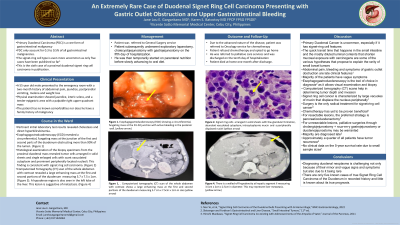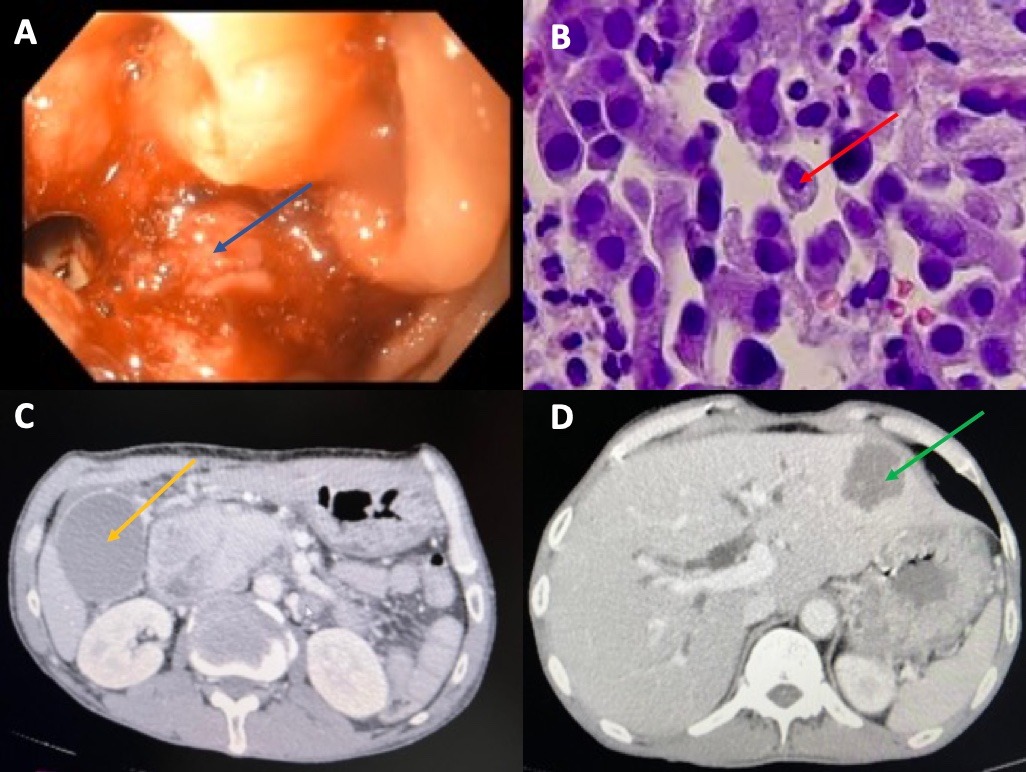Sunday Poster Session
Category: Small Intestine
P1266 - An Extremely Rare Case of Duodenal Signet Ring Cell Carcinoma Presenting With Gastric Outlet Obstruction and Upper Gastrointestinal Bleeding
Sunday, October 22, 2023
3:30 PM - 7:00 PM PT
Location: Exhibit Hall

Has Audio

Jane Lou E. Gargaritano, MD
Vicente Sotto Memorial Medical Center
Cebu, Cebu, Philippines
Presenting Author(s)
Jane Lou E.. Gargaritano, MD, Karen S. Batoctoy,
Vicente Sotto Memorial Medical Center, Cebu, Cebu, Philippines
Introduction: We present an extremely rare case of a duodenal signet-ring-cell carcinoma in a 55-year-old male who presented with vomiting and melena. Primary Duodenal Carcinoma (PDC) is a rare form of gastrointestinal malignancy and the signet-ring cell type is even more uncommon as only five cases have been published so far. This is the sixth case of a proximal duodenal signet ring cell carcinoma in English-language publications.
Case Description/Methods: A 55-year old male presented to the emergency department with a two-month history of abdominal pain, jaundice, postprandial vomiting, melena and weight loss. Physical examination showed jaundice, icteric sclera, and a tender epigastric area with a palpable right upper quadrant mass. In the emergency room, a diagnosis of Upper Gastrointestinal Bleeding and Gastric Outlet Obstruction secondary to Gastric Malignancy with probable hepatic metastasis was entertained.
Discussion: Primary Duodenal Carcinoma (PDC) is a rare form of gastrointestinal malignancy but signet-ring cell type is even more uncommon as only five cases have been published so far. This is the sixth case of a proximal duodenal signet ring cell carcinoma in publication. Symptoms of primary duodenal malignancy can be mild or nonspecific which leads to PDC being often misdiagnosed or missed in the early stage. When advanced, it presents as abdominal pain, obstruction and hemorrhage. Tumor markers may also be normal or only slightly elevated. The advent of advanced imaging as well as endoscopic methods makes way for better identification of duodenal malignancies. Currently, endoscopy is the diagnostic test of choice for the evaluation of duodenal cancers. Enhanced CT and MRI can also be used to assess tumor depth and lymph node invasion. On histology, signet-ring cell carcinomas are identified by cells with signet-ring appearance filled with intracytoplasmic mucin. Surgery is the only radical treatment for signet ring cell cancer. Chemotherapy has yet to be proven beneficial. For resectable lesions, the preferred strategy is pancreaticoduodenectomy. Majority of patients are diagnosed late and approximately 25% will have tumor recurrence. Unfortunately, no clinical data on the 5-year survival rate due to small sample sizes.

Disclosures:
Jane Lou E.. Gargaritano, MD, Karen S. Batoctoy, . P1266 - An Extremely Rare Case of Duodenal Signet Ring Cell Carcinoma Presenting With Gastric Outlet Obstruction and Upper Gastrointestinal Bleeding, ACG 2023 Annual Scientific Meeting Abstracts. Vancouver, BC, Canada: American College of Gastroenterology.
Vicente Sotto Memorial Medical Center, Cebu, Cebu, Philippines
Introduction: We present an extremely rare case of a duodenal signet-ring-cell carcinoma in a 55-year-old male who presented with vomiting and melena. Primary Duodenal Carcinoma (PDC) is a rare form of gastrointestinal malignancy and the signet-ring cell type is even more uncommon as only five cases have been published so far. This is the sixth case of a proximal duodenal signet ring cell carcinoma in English-language publications.
Case Description/Methods: A 55-year old male presented to the emergency department with a two-month history of abdominal pain, jaundice, postprandial vomiting, melena and weight loss. Physical examination showed jaundice, icteric sclera, and a tender epigastric area with a palpable right upper quadrant mass. In the emergency room, a diagnosis of Upper Gastrointestinal Bleeding and Gastric Outlet Obstruction secondary to Gastric Malignancy with probable hepatic metastasis was entertained.
Discussion: Primary Duodenal Carcinoma (PDC) is a rare form of gastrointestinal malignancy but signet-ring cell type is even more uncommon as only five cases have been published so far. This is the sixth case of a proximal duodenal signet ring cell carcinoma in publication. Symptoms of primary duodenal malignancy can be mild or nonspecific which leads to PDC being often misdiagnosed or missed in the early stage. When advanced, it presents as abdominal pain, obstruction and hemorrhage. Tumor markers may also be normal or only slightly elevated. The advent of advanced imaging as well as endoscopic methods makes way for better identification of duodenal malignancies. Currently, endoscopy is the diagnostic test of choice for the evaluation of duodenal cancers. Enhanced CT and MRI can also be used to assess tumor depth and lymph node invasion. On histology, signet-ring cell carcinomas are identified by cells with signet-ring appearance filled with intracytoplasmic mucin. Surgery is the only radical treatment for signet ring cell cancer. Chemotherapy has yet to be proven beneficial. For resectable lesions, the preferred strategy is pancreaticoduodenectomy. Majority of patients are diagnosed late and approximately 25% will have tumor recurrence. Unfortunately, no clinical data on the 5-year survival rate due to small sample sizes.

Figure: Figure A. Endoscopy showing a circumferential, fungating mass at the D1-D2 junction with active bleeding in the posterior wall (blue arrow)
Figure B. Signet ring cells with abundant vacuolated cytoplasm and displaced nuclei (red arrow)
Figure C. CT scan of the whole abdomen shows a large enhancing mass at the first and second portions of the duodenum (yellow arrow)
Figure D. There is a walled-off hypodensity at hepatic segment II. This may represent liver metastasis. (green arrow)
Figure B. Signet ring cells with abundant vacuolated cytoplasm and displaced nuclei (red arrow)
Figure C. CT scan of the whole abdomen shows a large enhancing mass at the first and second portions of the duodenum (yellow arrow)
Figure D. There is a walled-off hypodensity at hepatic segment II. This may represent liver metastasis. (green arrow)
Disclosures:
Jane Lou Gargaritano indicated no relevant financial relationships.
Karen Batoctoy indicated no relevant financial relationships.
Jane Lou E.. Gargaritano, MD, Karen S. Batoctoy, . P1266 - An Extremely Rare Case of Duodenal Signet Ring Cell Carcinoma Presenting With Gastric Outlet Obstruction and Upper Gastrointestinal Bleeding, ACG 2023 Annual Scientific Meeting Abstracts. Vancouver, BC, Canada: American College of Gastroenterology.
